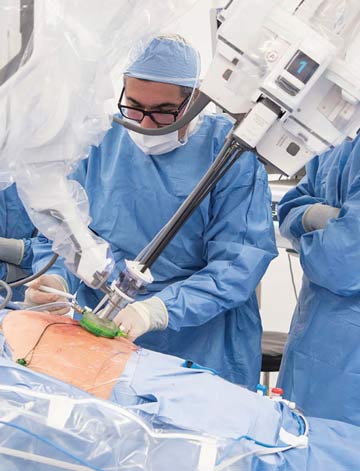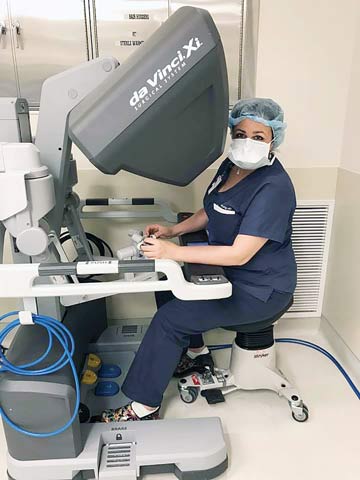A number of converging factors are making robotic abdominal surgery an intriguing prospect for many outpatient facilities. Intuitive's patents on the da Vinci robot, which has had the market cornered since 2000, are expiring. That's opening the door for new companies with streamlined platforms to emerge, and the increased competition offers the promise of less expensive robots, perhaps even affordable enough for surgery centers not affiliated with large hospital systems to purchase. More surgeons might soon have the opportunity to perform robotic-assisted surgery in an ever-widening field of procedures that produce shorter recovery times, lower wound infection risks, fewer hernias and less pain.
- Home
- Article
Advances in Abdominal Surgery Robots
By: Adam Taylor
Published: 4/9/2021
The prospect of new platforms coming online could lead to an increased use of robotics in outpatient facilities.
Adoption over time
In the early years of robotics, many general surgeons were very confident in their laparoscopic skills and felt like they wouldn't benefit from using the technology. But about five years ago, surgeons began to appreciate the benefits of robotic assistance as the platforms continued to advance and became more efficient to use, according to Daniel Shouhed, MD, director of the robotics simulation program at Cedars-Sinai Medical Center in Los Angeles. He says new instruments have come on board with the latest da Vinci system as well, including an improved stapling platform that didn't exist five years ago. Robotic assistance also provides surgeons with freedom of movement they can't achieve with straight-stick laparoscopic instruments. "Robotic arms have elbow and wrist joints that flex, and that articulation gives surgeons the dexterity that mimics the control they'd have during open surgery, while still providing all the benefits of minimally invasive laparoscopic surgery," says Dr. Shouhed.
That extra sense of control is why gynecologic and urologic surgeons were among the first specialists to adopt robotics. They often work in tight spaces within the pelvis, leaving them with little room to maneuver instruments. The increased articulation provided by robotics is also one of the main reasons use of the technology is increasing among hernia specialists, according to Shirin Towfigh, MD, FACS, a surgeon at Beverly Hills Hernia Center.
"Some procedures aren't conducive to using laparoscopic instruments," says Dr. Towfigh.
"When you're operating on the abdominal wall or deep in the pelvis, the space is so narrow that the straight instruments are parallel to tissue. The wrist-like joints on the robot allow surgeons to position the instruments perpendicular to tissue, which makes cutting and suturing much easier."
The learning curve on the da Vinci is shorter than it used to be and has allowed more physicians to tackle complex, revisional cases such as inguinal hernia repairs. For years, only about 10% of the surgeons in the country were able to perform them laparoscopically, according to Dr. Shouhed.
"Many surgeons have only seen difficult laparoscopic inguinal hernia cases once or twice during their residencies, so they don't feel comfortable offering it in their practice," adds Dr. Towfigh. "They know the minimally invasive option is a better operation, but they just don't do it. The majority of hernias performed in the United States are still done via open surgery, and robotic platforms can help narrow that gap."
Surgeons who had been resistant to the technology now use robots to perform smaller ventral hernia repairs, gallbladder procedures and some bariatric cases, all of which can be done outpatient. Most colon resections are still open procedures, but some physicians have begun using robotics to perform the procedures because of the increased articulation the technology provides.
Career extenders

Dr. Towfigh has been performing surgery since 2002, and has suffered neck problems and lumbar disc disease that required surgery. Had she not added robotics into her mix of procedures in 2013, her career could well be over. "While there's a genetic component to spinal disease, my spine surgeon is certain my problems were caused by my career," she says. "Before I had the surgery, my robotic days were a dream because when I was positioned in the robot, I had no pain."
Standing for hours at a time during open and laparoscopic surgery has long been known to cause joint pain, muscle pain in shoulders and necks and spine issues similar to what Dr. Towfigh experienced. Sitting at a console while operating is certainly better ergonomically for surgeons and puts much less wear and tear on the body.
The ergonomics of robotics aren't perfect, however. Surgeons are beginning to complain that their fingers are hurting more than they did in the past from constantly operating the joysticks, which require a lot of dexterity. Dr. Shouhed says the way he has to position his neck within the console to look at the screen can be uncomfortable, but says the overall robotic ergonomic experience is better than laparoscopic surgery. Dr. Towfigh notes that there's a business opportunity for a company that wants to design a chair to accompany the robotic systems. They currently don't come with one, and the quality of the chairs surgeons sit in varies widely from facility to facility.
Bright future

There's no doubt the da Vinci robot is cost prohibitive for most facilities. The patient cart, console and tower are a $2 million capital investment. The instruments are purchased separately and range from $1,500 to $3,000 a piece — and have a lifespan of 10 uses, so each instrument used costs $150 to $600 per case. Initially, says Dr. Shouhed, many older surgeons couldn't justify paying the da Vinci's high price tag, especially because they had trained for years to become master laparoscopic surgeons.
Anticipation of competition in the marketplace could increase access to the technology and make robots affordable for smaller facilities. "In the next two to five years, we're going to see established players in the surgery market coming out with their own products," says Dr. Shouhed. "That's healthy, and I hope the competition drops the price point."
He notes that Intuitive's 20 years of experience is a huge advantage and that any new players must offer an optimal system out of the gate. "If they come out with a platform that's not ready for prime time, it's not going to succeed," he says. "Surgeons must want to adopt and use it."
Intuitive has several "catalyst programs" across the county that involve veteran practitioners teaching best practices to newer robotics surgeons and create an environment to share ideas, provide training programs and help with constructing curriculums. Dr. Towfigh is hopeful to be part of a pilot program that would make her hernia center a model for having a da Vinci in an ASC. "Intuitive has really changed their business plan to try to saturate the market as much as possible before their competitors come online," she says.
Dr. Shouhed envisions a future with more precise robotic platforms that will be affordable for more surgeons to buy or lease, with advancements being added over time. For example, artificial intelligence could be built into the systems, allowing for the transposition of imaging studies onto surgical screens that would help physicians pinpoint the exact locations of tumors. In the future, there's also a real possibility that surgeons may be able to operate outside of the physical OR space using automated robotic platforms.
In the meantime, robotics will increase in all fields of surgery and help physicians expand their practices. "I know surgeons who were cool on the idea of adding robotics at first, who used to perform mostly open surgeries," says Dr. Shouhed. "Now, they do many of their procedures robotically." OSM
.svg?sfvrsn=be606e78_3)
.svg?sfvrsn=56b2f850_5)